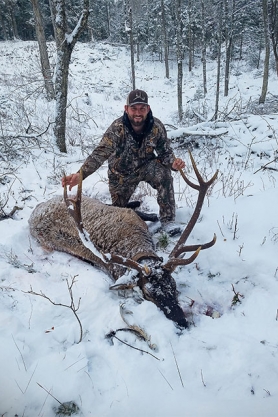Elk Hunting
Attention potential elk hunters: The 2024 Elk Application Period is open from April 10 through May 31. Find more information on how to apply below.
Season Dates, Regulations And Hours
Once eliminated from the state through overhunting, Wisconsin now boasts a healthy, growing elk population thanks to two restoration efforts, one in 1995 within the Clam Lake Elk Range and one in 2015 within the Black River Elk Range. By 2018, the Clam Lake Elk herd had grown enough in size to sustain a harvest. In October of that year, Wisconsin held its first managed elk hunt. In 2024, the Black River Elk herd is experiencing its first regulated hunt. These hunts are a testament to years of restoration, careful management and the strength of partnerships across agencies and states, tribal governments and non-profit organizations.
|
2024 Season Dates Archery, Crossbow and Firearm |
Oct. 12-Nov. 10 & Dec. 12-20 |
|---|
*Licenses awarded by drawing. Only bull elk may be harvested.
Hunting Hours – concurrent with Big Game Shooting Hours.
Shooting Hours
Hunting hours differ depending on the time of year and location (northern or southern half of the state). Hunters can use the following documents to check hunting hours in the part of the state they hunt.
Purchase A Hunting License
The 2024 Wisconsin Elk Hunt Application Period runs from April 10 through May 31. Only Wisconsin residents may apply.
New this year, applicants are required to select between the Black River Elk Range or Clam Lake Elk Range when applying.
To apply, visit your Go Wild account or a licensed agent to submit your application. Annual quotas will be announced at the May Natural Resources Board meeting, and drawing results will likely be available in June.
The application fee is $10.
Quotas: The Department of Natural Resources will approve an annual harvest quota based on the recommendation of the Elk Advisory Committee. Of the tags issued in the Clam Lake Elk Range, Ojibwe tribes may declare up to 50% of the quota, per treaty rights within the Ceded Territory. The other half will be randomly drawn for Wisconsin resident applicants. The full approved quota within the Black River Elk Range will be randomly drawn for Wisconsin state license holders.
Note: A person authorized to purchase a license for a permit or harvest authorization issued under a cumulative preference drawing may transfer their awarded permit or harvest authorization to another who meets the required qualifications on the Authorization Transfer webpage.
Elk Drawing Process
The 2024 Elk Hunting Application Period opens on April 10 and runs through May 31. All hunters who wish to be in the running for an elk harvest authorization should apply. The application fee is $10.
The drawing occurs in early June each year, and each license winner will be notified of their success. It is highly recommended that all personal contact information within the Go Wild system be updated to ensure efficient contact is made with successful applicants after the drawing occurs. Successful applicants must attend a mandatory elk hunter education course before being authorized to purchase an elk hunting license ($49).
Only one application may be submitted per person each year, and no preference points are given. This allows all applicants an equal opportunity to successfully draw an elk tag in Wisconsin. If a preference point system were used for elk in Wisconsin, due to the limited number of tags issued and the number of applicants each year, those who did not apply the first year would have virtually no chance of being awarded a tag in future drawings.
The application process is only open to Wisconsin residents when 100 or fewer elk hunting licenses are allocated, with exceptions for nonresident Purple Heart recipients and Armed Forces members who exhibit proof of meeting qualifying criteria. When more than 100 elk hunting licenses are issued, Wisconsin residents and nonresidents may apply.
A Wisconsin elk hunt is a once-in-a-lifetime opportunity. As the law currently states, you cannot apply through the application process if you have been previously selected in the state application or drawn in the Rocky Mountain Elk Foundation (RMEF) Raffle drawing.
A portion of each application fee is directly allocated to support elk management. For every $10 application fee, $7 is designated for elk management and research in Wisconsin. These funds are used to enhance elk habitat, which benefits the elk herd and wildlife within the elk management zones. Funding also contributes to ongoing elk research and monitoring. The remaining $3 covers administrative fees, vendor fees, etc.
Ojibwe Tribes And The Elk Hunt
The Ojibwe tribes reserved their right to hunt, fish and gather off-reservation when they signed treaties with the United States. These federally recognized treaty rights allow tribal members to hunt on public lands within the Ceded Territory of northern Wisconsin and reserve the right to declare up to 50% of the total harvest quota for a variety of wildlife, including elk on lands of the Ceded Territory. Tribal members who are Wisconsin residents can apply through the state drawing if they choose to do so. Non-tribal hunters are not allowed to participate in a tribal elk hunt.
The tribes of Wisconsin have been strong supporters and partners of elk reintroduction and management efforts. Elk's presence on the landscape and their ability to pursue elk have historically (and continue to be) been valued for subsistence, cultural, religious, medicinal, and economic significance to the Ojibwe Tribes and Ho-Chunk Nation.
Like deer, the Ojibwe tribal elk hunting season begins the day after Labor Day and runs through the first Sunday after New Year's Day. As is often the case, the Ojibwe tribes are anticipated to have some rules that differ from those required of state hunters. Great Lakes Fish and Wildlife Commission maintains tribal elk hunting rules and regulations and is available on the Great Lakes Indian Fish and Wildlife Commission's website.
Where To Hunt
For the first time since reintroduction, both the Clam Lake and Black River Elk Ranges will be open to hunting during the 2024 season. Each area provides ample hunting opportunities, mainly due to substantial public lands in the ranges. In addition, elk may be pursued on private property if landowner permission is granted.
Within both elk ranges, lands may be open for hunting under the Open Managed Forest Law or Forest Crop Law program. The DNR's Public Access Lands atlas is a valuable tool for locating public land open to hunting.
Clam Lake Elk Range
Public land comprises approximately 68% of the total land area in the Clam Lake Elk Range, including national, state, county and tax-law open forest ownerships. The general terrain is flat, with minor elevation changes throughout. The northern portion of the Chequamegon-Nicolet National Forest, Great Divide District, will include the greatest elevation. The majority of the Clam Lake Elk Range forested landscape is comprised of Northern Hardwood, Aspen or lowland forests. The greater Clam Lake and Flambeau area has ample accommodations, including several hotels, resorts, cabin rentals, and campgrounds, and it is within short proximity to many small towns and cities.
Maps of Clam Lake Elk Range:
Clam Lake Elk Range - Boundary Map
Clam Lake Elk Range - Landownership Map
Additional Resources:
Chequamegon-Nicolet National Forest: Great Divide District
Black River Elk Range
The Black River Elk Range lies within the central forest region and encompasses large portions of the Black River State Forest and Jackson County lands, offering excellent opportunities to pursue elk. Within the public lands, these areas are predominately forested, including cover types of oak, pine, mixed central hardwoods, and some aspen forests. The area of private land to the southwest region of the range transitions to private lands with a greater composition of agricultural lands. Throughout the range, changes in topography can be seen, which include flat to rolling; however, some areas offer increased elevation and topography. Although the Wazee Recreational Area is within Jackson County public lands, a section of the recreational area is prohibited from hunting; please follow the link below for additional information.
Black River Elk Range Maps:
Black River Falls Elk Range - Boundary Map
Black River Falls Elk Range - Landownership Map
Additional Resources:
Hunting Safety Tips
Elk hunters must carry proof of their elk hunting license and elk carcass tag.
- Proof of a license may include an original or reprinted paper copy, a Go Wild conservation card, a Go Wild-authenticated Wisconsin driver's license or a digital PDF file issued by the DNR and displayed on an electronic device.
- Only an original or reprinted paper copy is accepted for the elk carcass tag.
Currently, there is no requirement to wear blaze orange or blaze pink. However, it is highly recommended that at least some highly visible clothing (vest, hat, etc.) be worn. Other types of hunting and recreation will occur during this period, in addition to elk hunting, so safety should be a high priority.
If the weapon is legal for deer hunting in Wisconsin, it is legal for elk hunting. As such, elk may be hunted with harpoons, including vertical bow, crossbow, muzzleloader, centerfire handgun or centerfire firearm.
Hunter Logistics
All license winners must attend an elk hunter education course before they are eligible to receive an elk hunting license. Hunters will be introduced to various topics related to Wisconsin elk management and research, the history of the Wisconsin elk reintroduction, hunt preparation, rules and regulations, registration process, disease/tissue sampling and more. Hunters will also have the chance to meet DNR staff members and partners to ask elk hunting or related questions.
The location and timeframe will be shared with successful drawing winners in the given year. The course is free of charge but is mandatory. Hunters who did not successfully draw an elk tag will not be permitted to attend the elk orientation course.
If you intend to hunt alone, you must comply with hunter education requirements as are in place for all hunting activities in Wisconsin, including passing an official hunter safety class. The elk hunter education course does not qualify for the hunter education requirement.
Mentored hunting is allowed. A hunter who has not obtained hunter education requirements may still participate with a qualified mentor. The mentor must hold a valid Wisconsin hunting license of any type. The mentor may carry a weapon if hunting other game, such as deer, during an open deer hunting season or if the mentor possesses a concealed carry permit. The mentor is not authorized to kill an elk for a mentee unless dispatching a wounded elk for a mentee who is age 17 or younger. Visit the mentored hunting page for more information.
Additional people may accompany a licensed elk hunter on the hunt. However, group hunting is prohibited. Only the person issued the elk hunting license may shoot an elk. Having extra people along may be particularly helpful in recovering an elk from the field. There is no limit to the number of people who may accompany or assist the hunter. If hunting on enrolled acres through the Wisconsin Damage Abatement and Claims Program (WDACP), all members of the party must individually be granted permission to access the land.
Elk may be divided into as many as five pieces. The head must remain attached to one of the five parts of the carcass, and the bones must stay as part of each piece. Elk cannot be "boned out," as is standard on western elk hunts. If removed, the hide and lower legs do not count as one of the five parts. All parts must be removed from the field except the internal organs,
Register A Harvest
Upon harvesting an elk, the elk carcass tag must be immediately validated by removing the bottom portion (validation stub). Hunters are encouraged to protect paper tags. The tag must be attached to the elk if the hunter leaves the animal temporarily. If you leave it, tag it.
All harvested elk must be registered and are required to present their elk in person by 5 p.m. the day after recovery. To do so, they must contact a local wildlife biologist to register the elk in the field or at a mutually agreed-upon meeting place. Instruction and details will be provided to the hunters at the elk hunter education course. The elk may not leave the designated elk range unless the registration process has been started with a wildlife biologist.
GameReg is not an available option for elk registration. After in-person registration is completed, department staff will enter the hunter's elk in GameReg. The harvest record will appear on the hunter's Go Wild account. The elk registration confirmation number will then be available to the hunter.
Hunters will be provided tissue sampling kits at orientation for herd health sampling. Hunters will be asked to provide CWD tissue samples at registration, which include lymph nodes and obex. Additional tissue samples may include lung, liver, skin, and a tooth.
Elk Health & Diseases
The unique nature of a small, reintroduced elk population in Wisconsin has provided the opportunity to test a high percentage of the individuals for exposure to diseases of significance to elk, humans and domestic animals. Since the initial reintroduction of the northern elk population in 1995, intensive monitoring using radio collars has allowed for a sound background on the exposure of elk to diseases of concern and prompt mortality investigations to determine the cause of death.
Through regular capture and handling of elk in Wisconsin, blood and fecal samples have been collected to evaluate exposure to organisms responsible for Brucellosis, Johne's Disease, Bluetongue, Epizootic Hemorrhagic Disease (EHD), Leptospirosis, Eastern Equine Encephalitis, Western Equine Encephalitis, Venezuelan Equine Encephalitis, West Nile Virus (WNV), Anaplasmosis, Neosporosis, Bovine Herpes, Infectious Bovine Rhinotracheitis (IBR) and Bovine Viral Diarrhea (BVD). These surveillance efforts have revealed either limited exposure by Wisconsin elk (WNV and EEE) or no identified exposure (all others). These tests represented both surveillance efforts for diseases that elk have been identified as compatible hosts for, and sources of, infection that are not present in Wisconsin (Brucella species) as well as investigatory in evaluating possible diseases that could impact elk populations.
Based on the diseases and parasites that have been identified within Wisconsin and a desire to prevent the introduction of diseases not present within the state, a testing plan was developed in collaboration with other state and federal agencies for the 2015-2019 elk translocation from Kentucky. The plan included testing for diseases that primarily affect wildlife and those that primarily affect domestic animals but can spill over into wildlife and included testing for Bovine Tuberculosis (TB), Bovine Brucellosis (Brucella abortus), Bovine Viral Diarrhea Virus, Bluetongue and Epizootic Hemorrhagic Disease. The protocol outlined in that plan was executed fully, and no elk were identified as infected with these diseases.
Chronic Wasting Disease in Elk
Chronic wasting disease (CWD) is a fatal, infectious nervous system disease of deer, moose, elk and reindeer/caribou. It belongs to the family of diseases known as transmissible spongiform encephalopathies (TSEs) or prion diseases.
The DNR began monitoring the state's wild white-tailed deer population for CWD in 1999. The first positive detections were found in 2002 in Dane County, approximately 250 miles from the Northern Elk Management Zone and approximately 120 miles from the Central Elk Management Zone. Before the most recent reintroduction, extensive testing was conducted within both elk management zones to monitor for CWD. During translocation, additional measures were also taken to ensure that equipment and staff were not transmitting the prion that causes CWD to translocated elk. As of February 2024, 227 elk have been tested, and no wild elk tested positive for CWD in Wisconsin.
Other Considerations for Elk Health
Baiting And Feeding: Currently, baiting and feeding for elk are prohibited by the Administrative Code. Wisconsin's current prohibition on baiting and feeding for elk is a strong management tool with multiple benefits. In Wisconsin, recreational feeding of elk has been responsible for multiple vehicle collisions as elk crossed roadways to reach backyard feeding operations, and prohibitive rule changes helped drastically reduce roadway mortality. Additionally, baiting/feeding has caused several elk mortalities via metabolic toxicity associated with grain overload (the introduction of readily digestible carbohydrates, such as corn, that their rumen cannot process appropriately).
Rehabilitation: The behavior and nature of elk make them an unlikely candidate for inclusion in wildlife rehabilitation efforts, and it is recommended that they are not included in these endeavors.
Previous Elk Hunts
Elk Hunt 2023
The 2023 Elk Hunting Season had an approved quota of eight bull elk. This quota was only for the Clam Lake Elk Range. Tribal hunters and state hunters each harvested four bull elk to meet the approved quota. Some highlights include the first modern-day traditional archery harvest and the first youth hunter harvest, both pictured below.
Elk Hunt 2022
The 2022 elk hunting season was completed with the successful harvest of eight bull elk. Each state-licensed hunter and member of the Ojibwe tribes harvested four elk. One state-licensed hunter finished the first modern-day vertical bow-harvested elk in Wisconsin. 2022 also marked this final year (2018-2022) in which Rocky Mountain Elk Foundation held a drawing to issue one tag from the State of Wisconsin portion of the elk harvest quota.
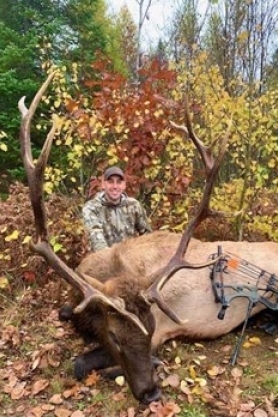
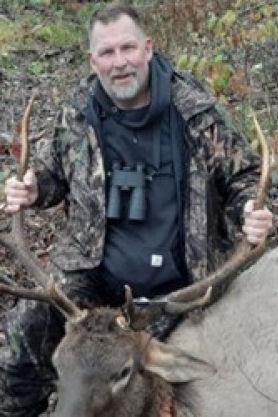
Elk Hunt 2021
In the fall of 2021, Wisconsin hunters pursued four bull elk while Ojibwe hunters harvested four bull elk under the guides of an evenly split 8-bull elk quota. Three DNR-licensed hunters completed their harvest.
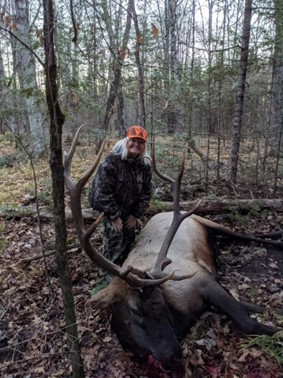
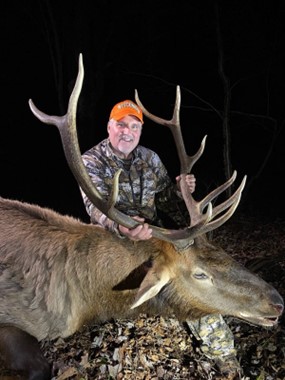
Elk Hunt 2020
The 2020 elk hunting ended with all five state hunters harvesting an elk in the Clam Lake Range.
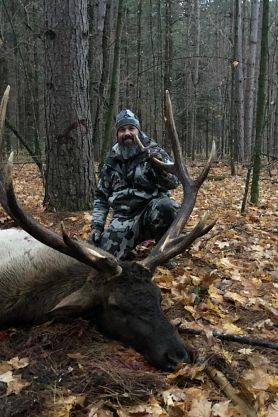
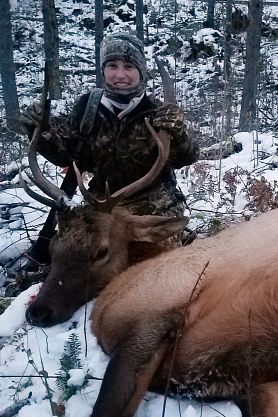
Elk Hunt 2019
The 2019 elk season concluded with the harvest of the tenth bull on Nov. 10, 2019. The 10-bull quota for 2019 was met, with five bulls being harvested by state hunters and five bulls by the members of the Ojibwe Tribes. The 2019 Wisconsin elk hunt occurred only within the Clam Lake elk range in Ashland, Bayfield, Price and Sawyer counties.


Elk Hunt 2018
Wisconsin's first managed elk hunt in state history drew intense interest, with over 38,400 applicants in the state drawing and an additional 5,000 raffle tickets sold by the Rocky Mountain Elk Foundation. Nine bulls were harvested out of the 10-bull quota, including four bulls by state hunters during the 39-day hunt and five bulls by members of the Ojibwe Tribes.

